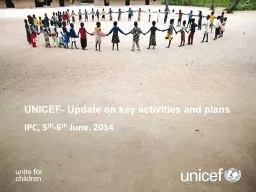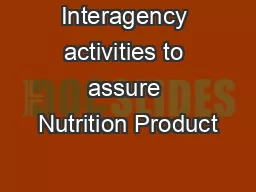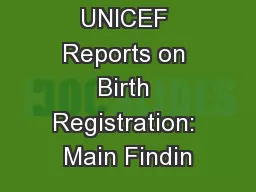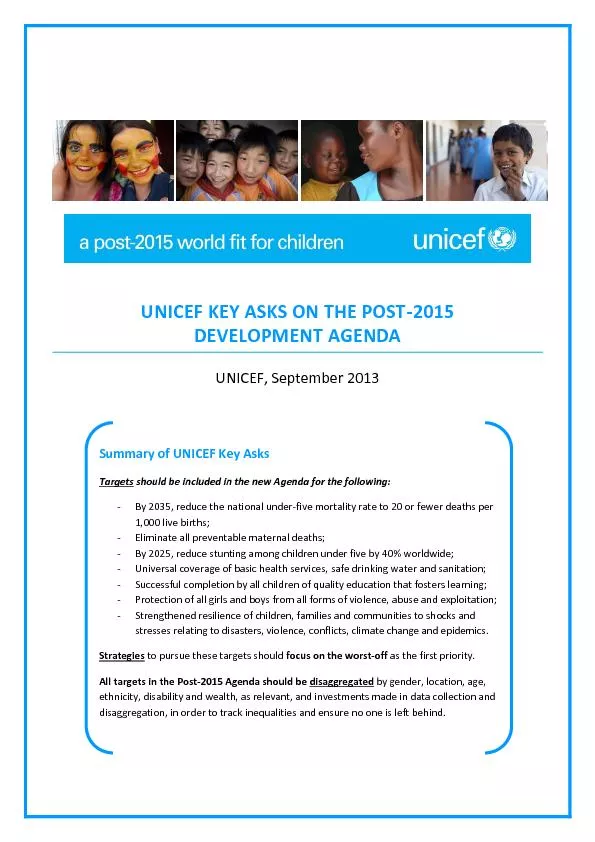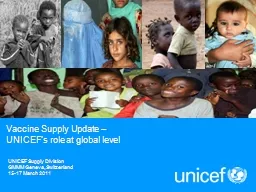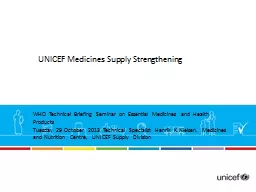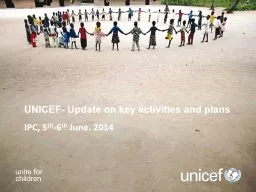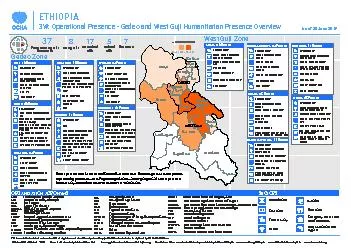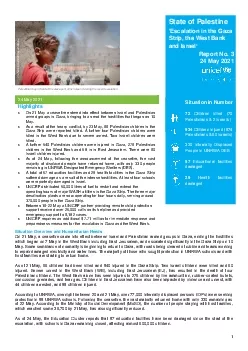PPT-UNICEF- Update on key activities and
Author : olivia-moreira | Published Date : 2016-08-06
plans IPC 5 th 6 th June 2014 Procurement in support of programmes 2013 Supplies and services for 134 countries and areas Total procured 2839 Emergency 127 Supplies
Presentation Embed Code
Download Presentation
Download Presentation The PPT/PDF document "UNICEF- Update on key activities and" is the property of its rightful owner. Permission is granted to download and print the materials on this website for personal, non-commercial use only, and to display it on your personal computer provided you do not modify the materials and that you retain all copyright notices contained in the materials. By downloading content from our website, you accept the terms of this agreement.
UNICEF- Update on key activities and: Transcript
plans IPC 5 th 6 th June 2014 Procurement in support of programmes 2013 Supplies and services for 134 countries and areas Total procured 2839 Emergency 127 Supplies to 33 countries and areas. on the measurement of child disability. Claudia . Cappa. , PhD, . Statistics and Monitoring Section, UNICEF, NY. Objectives. Update . on . UNICEF’s current . and future activities on child disability . quality. Background and Progress Update. Overview. Interagency Group members. A brief historical account of the Humanitarian Aid sector. Growth of procurement of Nutritional products. Response in QA systems strengthening of agencies to the increase demand in Nutritional products. I. mplications . 12 December 2013. Birth registration must be within . the . civil registry. A birth can only be registered by this authority. Ideally this is a national authority or, if not, there is a mechanism to ensure national coordination. - 2015 DEVELOPMENT AGENDA UNICEF, September 2013 Summary of UNICEF Key Asks Targets should be included in the new Agenda for the following: - By 2035, reduce the national under - five mortality rate GMMM Geneva, Switzerland. 15-17 March 2011. Vaccine Supply Update –. UNICEF’s role at global level. The procurement of vaccines and related supplies is UNICEF's largest procurement activity, conducted on behalf of . Update on key . activities. IPC Meeting. UNICEF Supply Division, Copenhagen, 18-19 June 2015. Health. HIV/AIDS. WASH. Nutrition. Education. Protection. Inclusion. Supply Strategies. Service . Delivery . IPC Meeting. Washington, 6-7 June 2016. UNICEF expenditure by . material groups, 2015. Global & local warehousing & transport. Kit-packing targets. Reduce . lead-time. Health . kit-packing in Africa & India. . WHO . Technical Briefing Seminar on Essential . Medicines and Health Products. Tuesday . 29 . October . 2013 Technical . Specialist . Washington, 6-7 June 2016. UNICEF expenditure by . material groups, 2015. Global & local warehousing & transport. Kit-packing targets. Reduce . lead-time. Health . kit-packing in Africa & India. IPC Meeting. UNICEF Supply Division, Copenhagen, 18-19 June 2015. Health. HIV/AIDS. WASH. Nutrition. Education. Protection. Inclusion. Supply Strategies. Service . Delivery . Emergency. Influencing . plans. IPC, 5. th. -6. th. June. 2014. Procurement in support of . programmes. - 2013. Supplies and services for 134 countries and areas. Total procured. $2,839. Emergency. $. 127. Supplies to 33 countries and areas. ETHIOPIAGedeo and West Guji Humanitarian Presence OverviewGedeo ZoneWest Guji Zone As of 30 June 2019 ORGANIZTION ACRONYMS ProtectionEmegency Shelter and Non-ood ItemsWate, Sanittion and HygieneEducti 1On 21 May a ceasefire came into effect between Israel and Palestinian armed groups in Gaza ending the hostilities Jerusalem and escalated significantly in the Gaza Strip on 10 May Some semblance of n UNICEF Strategyto PreventSexual Exploitationand Abuseand Sexual HarassmentJanuary 20191Contents1BACKGROUND211 Introduction212 Purpose and Scope22VISION321Vision322Goals323Principles324Values43STRATEGI
Download Document
Here is the link to download the presentation.
"UNICEF- Update on key activities and"The content belongs to its owner. You may download and print it for personal use, without modification, and keep all copyright notices. By downloading, you agree to these terms.
Related Documents

